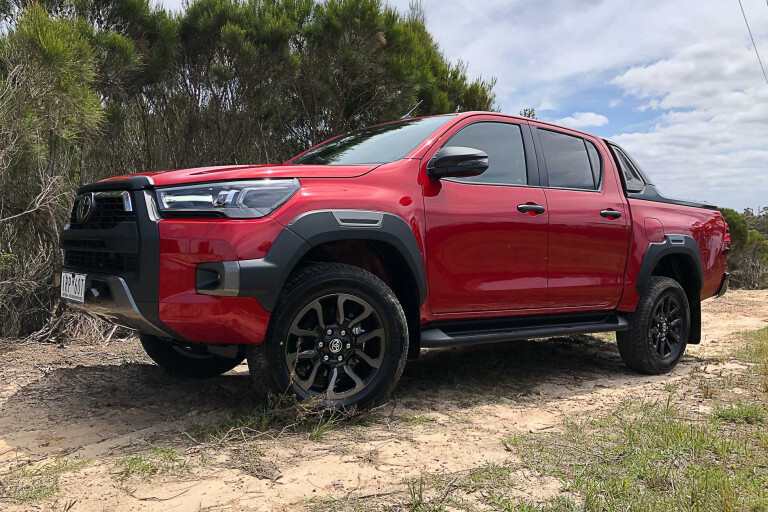
What is the 2020 Toyota HiLux Rogue?
Australia’s outlier position with dual-cab utes remains unchecked as we head into a new decade.
Our fascination with dual-cab 4x4s stems partly from fashion and mostly from economic pragmatism, as small business and family life collides in a tax-friendly way to push the ute further into the mainstream.

The eighth-generation Toyota HiLux launched in 2015 with new engines and safety technology to cement the vehicle’s place at the front of the queue with mining and construction companies, but the 2020 facelift addresses key areas like ride, handling and power output7 aimed squarely at the suburban-dwelling HiLux.
Introduced in 2018 to keep up with an influx of hotted-up utes from rivals like Ford and Nissan, the Rogue is the second-most expensive ute in the HiLux line-up.
But is it that much better than its cheaper siblings?
Price and value
The Toyota HiLux Rogue, equipped with a 2.8-litre four-cylinder turbo-diesel engine and a six-speed automatic transmission, will cost you $68,990 plus on-road costs.
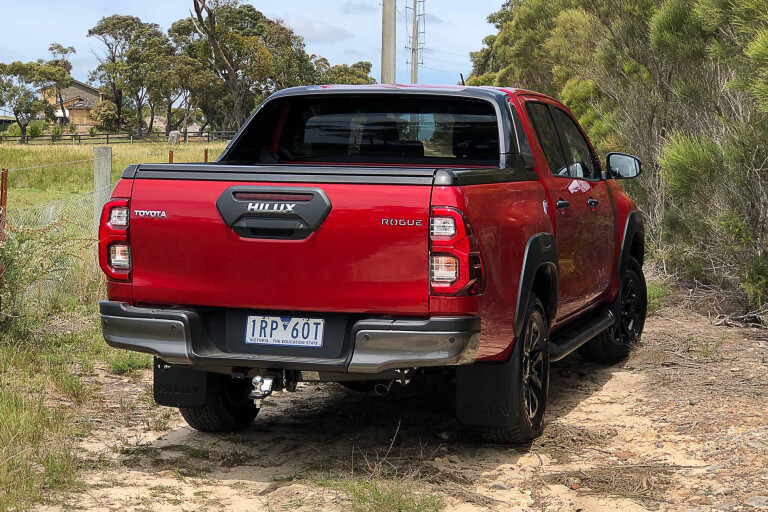
Dual-range 4x4 with hill descent control, adaptive cruise control, lane-keep assist, road sign detection and AEB with cyclist detection during the day, LED headlights and taillights, 18-inch alloys with highway-spec tyres, a new 8.0-inch multimedia system with Apple CarPlay and Android Auto and a small digital dash screen are standard, along with a 60/40 split base rear seat.
There's also a towbar and associated electrics, though it misses out on a brake controller unit.
The Rogue adds a bit to the mix, including a redesigned sport bar for the tray, carpet tub lining, an electric roller-shutter for the tub and 18-inch rims, along with a bespoke front bumper treatment and extra decals.
Mechanically, though, there is no change to the spec - and you can get exactly the same set-up on the $52,160 SR5. If you want leather seats, an SR+ costs $2000 more.
Ford’s 2.0-litre twin-turbo Ranger Wildtrak costs $64,940 in auto guise, by way of comparison, while Nissan’s Navara N-TREK Warrior costs $63,790.
Living with the Toyota HiLux
There’s not much in the way of change for the interior of the HiLux Rogue. A new instrument cluster insert offers up redesigned speedo and tacho dials and does include – hallelujah! – a digital speedometer for the first time in a HiLux.
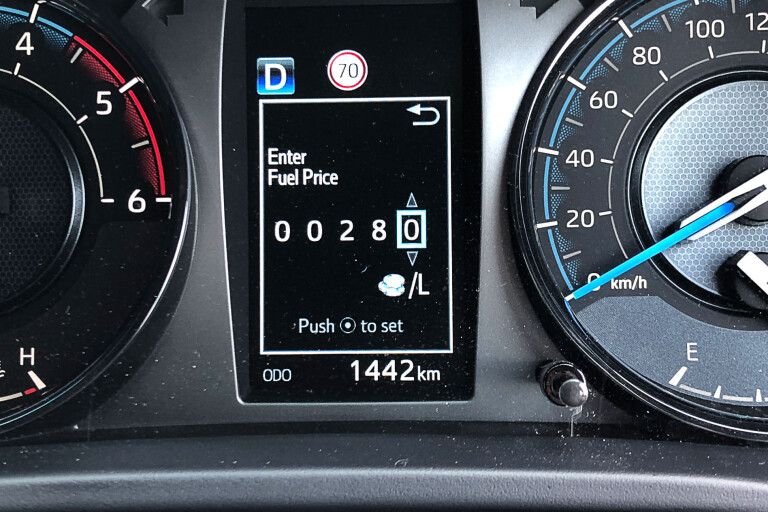
It also offers more data for the driver, but not to the extent of things like engine oil pressure or temperature.
The other big change is the addition of a larger 8.0-inch screen to the centre console. The new system is compatible with Apple CarPlay and Android Auto, along with something known as myToyota. This will allow owners to use other apps like Stitcher and AccuWeather, which aren’t supported by either phone interface.
The screen can be used via capacitive touch, with larger icons making it an easy job. Each function can be accessed via buttons, and many owners will be pleased to note that the volume knob has returned.
The Rogue’s seats are comfortable and supportive, and the steering wheel, while firm underhand, is comfortable over a longer journey. Rear seat occupants do sit quite vertically, which can be uncomfortable on a long stint, but there is plenty of headroom, toe room and shoulder room.
There are two ISOFIX points for baby seats, but the top tether points are tough to access if you’re looking to change seats between cars.
A big tick for the flip-down hook on the back of the front seat to hang that plastic bag-full of Friday night takeaway from, Toyota.
Storage in the doors and in the centre console is adequate (just), but the rock-hard plastic that’s used to make the small trays and the two cupholders means that rattling is a real drama on rough stuff.
The tray of a dual-cab is never the best place to store day-to-day stuff, but Toyota has added a powered roller shutter to the Rogue that cleans up the looks and adds some security.
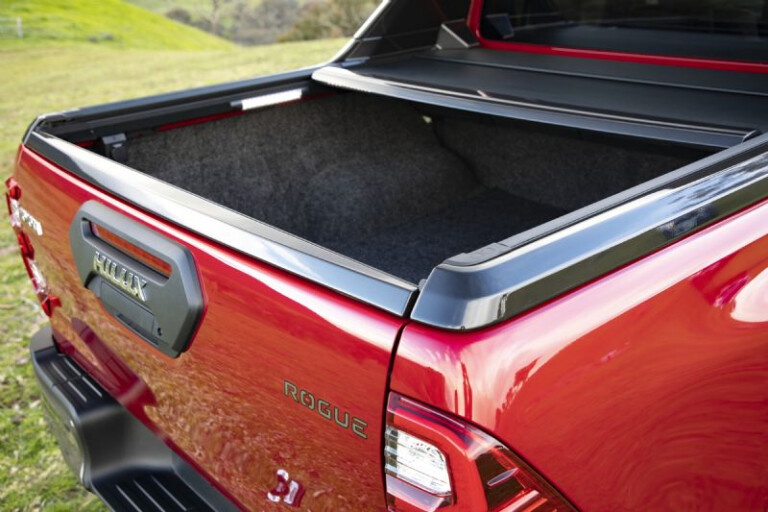
A marine-grade carpet tub liner is a new one for me, but it’s a lot kinder to objects carried in the back than either a plastic tub liner or spray-on protector.
The tailgate lacks any form of soft-open mechanism, though, slamming down with a loud clank when unlatched.
We’ll talk about how it drives in a minute, but the changes to the suspension have also improved the quietness inside the cabin of the HiLux, too.
Off-throttle, the engine quietens down nicely and aside from a little wind noise around the wing mirrors, the HiLux is easy to drive over longer distances.
However, it's always worth noting that the inherent characteristics of a dual-cab 4x4 utility - high centre of gravity, narrow track width, dual-purpose tyres - still exist, which make the HiLux and all of its rivals less safe to drive in urban situations than, say, a hatchback or station wagon.
Engine, transmission and drivetrain
Under the bonnet of the HiLux Rogue, the 2.8-litre four-cylinder turbocharged diesel engine has been considerably overhauled – but the more expensive Rogue doesn’t offer anything on top.
A larger, ball-bearing-equipped turbocharger, a stiffer cylinder block, better exhaust gas management and improved cooling help to boost outputs to 150kW (up 20kW) and 500Nm (up 50Nm) on the six-speed automatic version, and 420Nm for the six-speed manual version (despite what you might read elsewhere).
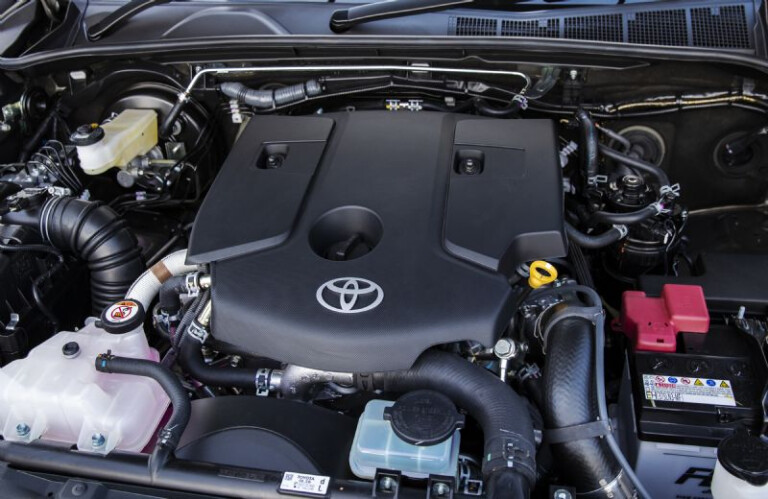
It’s still slightly down on the Ranger 2.0-litre twin-turbo’s 157kW, but the torque is now a match.
As well, the updated six-speed auto can now handle 3500kg of braked trailer, which is a 400kg jump over the previous version. Toyota says it's down to improved torque lock-up calibration.
The HiLux retains its dash dial-activated low-range 4x4 set-up, with the default drive mode being rear-wheel-drive. A hill control descent button and an old-school ‘idle-up’ button are the main electronic off-road aids.
Driving the Toyota HiLux Rogue
Toyota has worked hard to bring new updates to the HiLux.
Chief amongst these are the changes to the suspension, which has been tweaked to improve the HiLux’s previously brittle and busy unladen ride quality, especially when the rear end is empty.
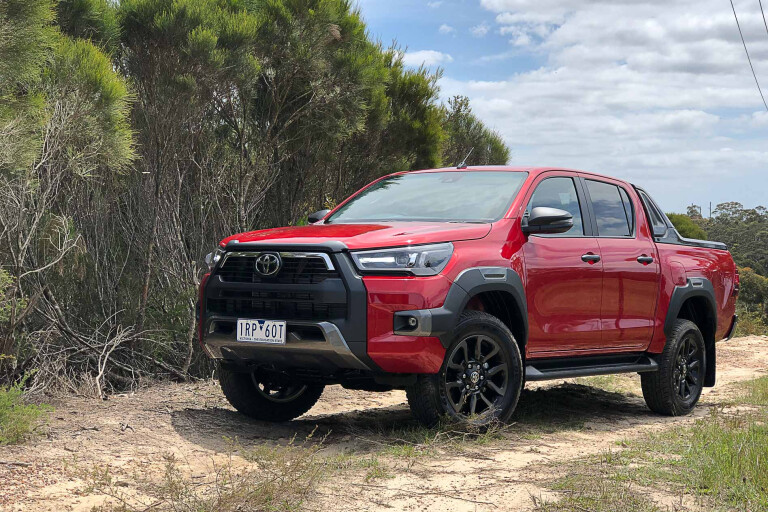
Lower-friction (read: more expensive) shocks, revised bushings and new longer, softer leaf springs combine with updated bushes that sit between the body and the ladder-frame chassis to give the HiLux a much more mature, controlled and overall more pleasant ride quality.
Steering feel, too, has been improved. Toyota has kept the older-style hydraulic steering assistance for the HiLux because it claims it’s more reliable off-road.
A variable ratio pump has been added to the system, which works harder at low speed to lighten the steering effort and firming it up at higher road speeds.
Overall, the HiLux is now quieter, much more compliant over small bumps and breaks in the road and it generally feels much more refined – and it needed to, given the quality of its opposition.
Safety of the Toyota HiLux Rogue
There’s no change to the HiLux’s five-star ANCAP safety rating, which was a major goal during the development of the eighth-gen ute.

However, the active safety equipment level of the HiLux (including high-speed AEB with daytime cyclist detection, trailer sway control, lane-keep assist and adaptive cruise control) is being challenged by rivals like the new Isuzu D-MAX, which also offers rear cross-traffic detection and blind-spot warning on higher-spec models.
How much does it cost to run the Toyota HiLux Rogue?
The HiLux’s servicing intervals of six months or 10,000km are shorter than those on key rivals like the Ranger (15,000km/12 months) and are, consequently, more expensive when it comes to fixed-price service plans.
A capped-price service plan over five years will cost $3537, with the first four services capped at $250 each.
The HiLux uses standard diesel and doesn’t need AdBlue to treat its exhaust system, though the fuel filler cap hides a blanked-off second filler neck.
At a claimed combined fuel economy figure of 7.0 litres/100km, the Toyota HiLux Rogue’s 80-litre fuel tank allows a theoretical range of 1150km on one tank of diesel.
Over 260km of testing, we used 8.7L/100km over city and highway.
Verdict – the 2020 Toyota HiLux Rogue
We’ve rated the 2020 Toyota HiLux previously against the prism of the more affordable SR5 variants, and came away impressed with the much-improved ride quality and engine refinement.
However, the value proposition of the Rogue is questionable; the nearly-$15,000 ask over the top of the SR+ or even the $6500 uptick over the SR5+ for what is essentially a cosmetic makeover is tough to justify, in our view. It looks sharp, sure, but it’s a big jump.

Rating 3.5/5
What you will like
Much more comfortable, smoother and calmer to drive
What you won’t
The add-ons don’t add much other than looks
Specifications
Price: From $68,990 (6AT)
Engine/Transmission: 2.8-litre 4cyl turbo diesel
Fuel consumption/CO2/Tank size: 7.0L/100km, 212g/km, 80L
Safety: 5 stars
Seats: 5
Warranty / Service Interval: five years/160,000km, 10,000km/6 months
Spare Wheel (type): full size
Weight: 2050kg

COMMENTS